If you’re dealing with a bed bug infestation, eliminating adult bed bugs alone won’t solve your problem. The real horror lies in breaking the reproductive cycle by destroying both the adults and their eggs. Without addressing bed bug eggs, even the most thorough extermination efforts can fail, allowing the infestation to continue unchecked.
Quick Picks: Best Products for Bed Bug Eggs

Editor’s Choice

Budget Pick
Important Warning
If you were dealing with just one bed bug, your battle would be easy. The real challenge is that an infestation means fighting an entire, constantly reproducing population. Even if you eliminate every adult bed bug, leaving eggs behind will result in a renewed infestation.
Professional Advice
For severe infestations, consider professional heat treatment, which can reach the necessary 118°F to kill all bed bugs and their eggs in one session. This is often more effective than DIY chemical treatments.
When to Act
Don’t delay treatment. Each female bed bug can lay up to 500 eggs in her lifetime, with 1-5 eggs daily. Swift, comprehensive action is essential to prevent exponential growth of the infestation.
- Understanding Bed Bug Eggs: The Hidden Threat
- Bed Bug Larvae and Nymphs: The Next Generation
- How to Get Rid of Bed Bug Eggs and Nymphs
- What Kills Bed Bug Eggs Effectively
- Dealing with Bed Bug Eggs on Clothing
- Heat Treatment: The Most Effective Solution
- Conclusion: Breaking the Bed Bug Life Cycle
- Frequently Asked Questions
Understanding Bed Bug Eggs: The Hidden Threat
The real horror of bed bugs is that an infestation means you’re fighting an entire, constantly reproducing population. Even when every adult bed bug has been eliminated, overlooking the eggs can render your efforts pointless. A single surviving pregnant female bed bug can restart the entire infestation cycle.
What Do Bed Bug Eggs Look Like?
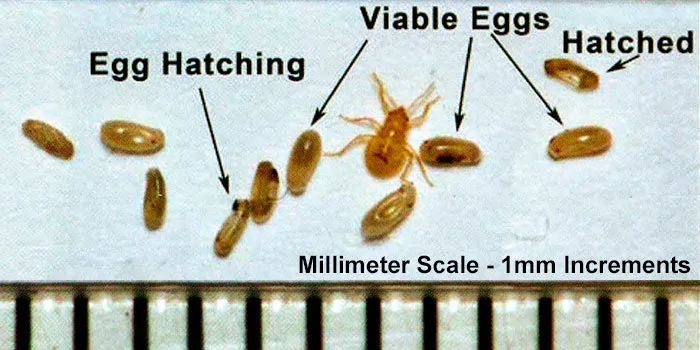
Appearance:
- Grain-like shape
- Milky-white coloration
- Approximately one millimeter in length
- Usually found in small clusters
Where to Find:
- In cracks and crevices
- Along mattress seams
- Behind headboards
- In box spring corners
- On clothing and bedding
Identification Tips:
- Visible to naked eye with careful inspection
- May have a slight sheen
- Often clustered in hidden locations
- Look for fecal spots nearby (dark stains)
Bed bug eggs are typically hidden in inaccessible cracks and crevices, making them difficult to find. However, you may also discover them on clothing, pillows, bed sheets, mattresses, or box springs. Their strategic placement in hard-to-reach areas contributes to the challenge of complete eradication.
Detection Tip
Use a credit card to scrape along mattress seams, behind headboards, and in furniture crevices to help dislodge and reveal hidden bed bug eggs. A flashlight will make the tiny white eggs more visible during inspection.
Bed Bug Egg Hatching Time
| Life Stage | Duration | Characteristics |
|---|---|---|
| Eggs | 6-10 days until hatching | Milky white, 1mm, grain-shaped |
| Nymphs (1st-5th instars) | 5 weeks (with regular feeding) | Translucent to brown, increasing in size |
| Adults | 4-6 months (up to 1 year) | Brown, apple-seed sized, oval bodies |
Understanding the bed bug life cycle is crucial for effective treatment timing. Bed bug eggs typically hatch within 6-10 days under normal conditions, though environmental factors like temperature can affect this timeframe. Female bed bugs lay between 1-5 eggs daily and can produce up to 500 eggs in their lifetime, which explains how infestations grow rapidly.
Adult bed bugs typically live 4-6 months, but under favorable conditions, they can survive up to a year. They can also go without feeding for up to a year in some cases, contributing to their resilience as pests.
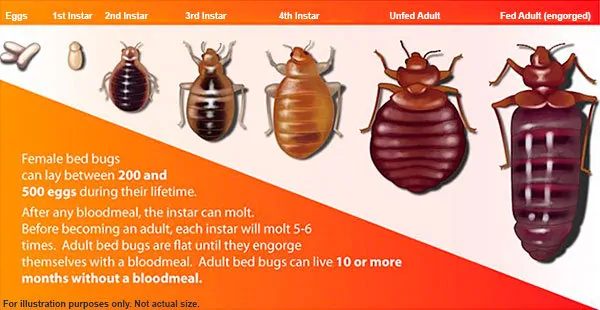
Bed Bug Larvae and Nymphs: The Next Generation
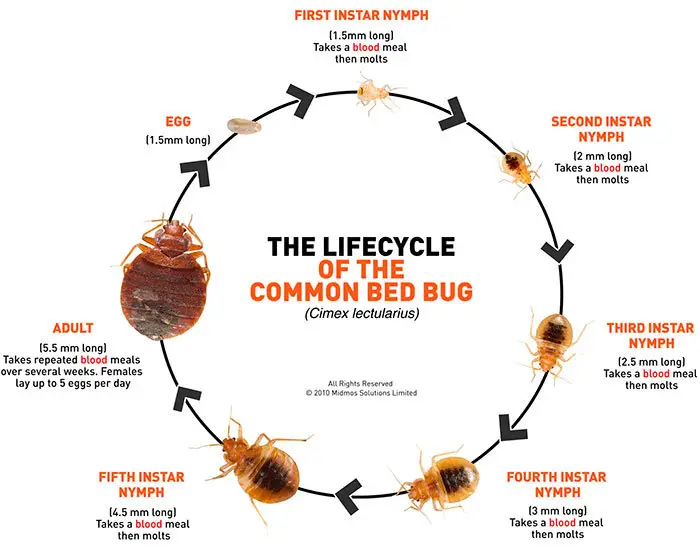
When bed bug eggs hatch, they produce “nymphs” rather than larvae (technically, bed bugs don’t have a larval stage like some other insects). These nymphs are essentially miniature versions of adult bed bugs with some key differences:
- They appear more transparent than adults, except after feeding
- They start at about 1.5mm long and grow to 9mm at full maturity
- Nymphs molt and go through several developmental stages
- They begin seeking blood meals immediately after hatching
As nymphs develop, they leave behind casings on your mattress or in carpeting, along with fecal stains (digested blood). Both nymphs and adults lack wings and have flat bodies, though adults become more elongated after feeding.
How to Get Rid of Bed Bug Eggs and Nymphs
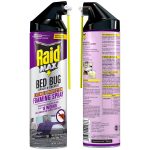
Insecticides
- Kills nymphs and adults on contact
- Limited effectiveness against eggs
- Requires repeat applications
- Residual protection deters reinfestation

Diatomaceous Earth
- Kills eggs, nymphs and adults
- No resistance issues
- Non-toxic when used properly
- Works gradually over 1-2 weeks
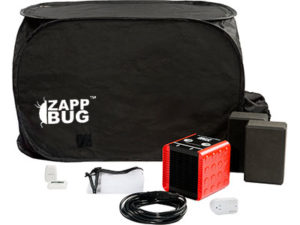
Heat Treatment
- Kills all life stages including eggs
- One-time treatment (often sufficient)
- No chemical residue
- Requires specialized equipment
Most insecticides and bed bug treatments that kill adult bed bugs will also eliminate nymphs. However, eggs often survive these treatments, which necessitates either:
- Using specialized treatments designed to kill eggs
- Repeating treatments approximately two weeks apart to kill newly hatched nymphs before they mature
Always read product claims carefully, as some treatments are more effective against eggs than others. In reality, there is no guaranteed chemical solution that kills 100% of bed bug eggs, which is why multiple treatment approaches are necessary.
Treatment Schedule for Complete Eradication
Follow this timeline for the most effective results
Day 1: Initial Treatment
-
Apply insecticides
Target cracks, crevices, and all bed bug hiding spots -
Apply diatomaceous earth
Create barriers around bed legs and along baseboards -
Heat-treat bedding
Wash and dry all bedding on high heat
Days 2-13: Monitoring Period
-
Vacuum daily
Remove dead bugs, eggs, and casings -
Maintain barriers
Reapply DE as needed in high-traffic areas -
Check for activity
Use bed bug interceptors to monitor for survivors
Day 14: Follow-up Treatment
-
Reapply insecticides
Target any remaining activity areas -
Treat newly hatched nymphs
Kill any bugs that hatched since initial treatment -
Consider professional help
If infestation persists, contact professionals
Can You See Bed Bug Eggs?
Bed bug eggs are tiny but visible to the naked eye with careful inspection. Their distinctive appearance makes them identifiable once you know what to look for. However, their placement in small cracks and crevices makes them challenging to locate. Even if you don’t see the eggs, assume they’re present wherever adult bed bugs are found.
Common Questions About Bed Bug Eggs
How long does it take for bed bug eggs to hatch?
Bed bug eggs typically hatch within 6-10 days under normal room temperature conditions. Environmental factors like temperature and humidity can affect this timeframe—warmer conditions may accelerate hatching.
Can bed bug eggs survive washing?
Washing alone may not kill bed bug eggs. It’s the high heat of the dryer that’s most effective. Wash infested items in hot water, then dry them at the highest recommended temperature (at least 118°F) for a minimum of 30 minutes to ensure eggs are destroyed.
How many eggs do bed bugs lay at once?
Female bed bugs typically lay 1-5 eggs per day, but can produce up to 500 eggs in their lifetime. This rapid reproduction rate explains why small infestations can quickly grow into major problems if not addressed promptly.
What Kills Bed Bug Eggs Effectively
Since no single treatment guarantees complete egg elimination, a comprehensive approach is necessary. Here are the most effective methods for killing bed bug eggs:
Diatomaceous Earth (DE)
- DE creates a barrier that bed bugs avoid crossing, limiting egg-laying areas
- It’s non-toxic and all-natural, made from fossilized diatom shells
- It cuts into bed bug shells, killing them through dehydration over 1-2 weeks
- Bed bugs cannot develop resistance to DE
When using DE, only purchase food-grade diatomaceous earth intended for pest control. Avoid pool-grade DE or products mixed with pesticides. Always wear a mask when applying to avoid inhalation.
Food-Grade Diatomaceous Earth
Editor's ChoiceHow Does It Work
How to Use
- Wear a mask when applying to avoid inhaling the fine powder
- Apply a thin layer along baseboards, under beds, and in cracks where bed bugs hide
- Focus on areas where bed bugs travel, creating a barrier they must cross
- Reapply after cleaning or if the powder becomes wet
- All-natural and non-toxic when used correctly
- Bed bugs cannot develop resistance
- Long-lasting effect when kept dry
- Kills both adult bed bugs and their eggs
- Works slowly (takes 1-2 weeks to be fully effective)
- Must remain dry to be effective
- Requires careful application with proper respiratory protection
Rubbing Alcohol
- Apply to your skin before sleep to deter bed bugs from biting
- Spray directly on mattresses and box springs
- Apply under beds and along bedroom baseboards
Does Rubbing Alcohol Kill Bed Bugs?
Rubbing alcohol kills bed bugs on direct contact and can eliminate some eggs. It also soothes itchy bites and helps deter bed bugs from areas where it’s been sprayed. While not 100% effective alone, it’s an affordable component of a broader treatment strategy.
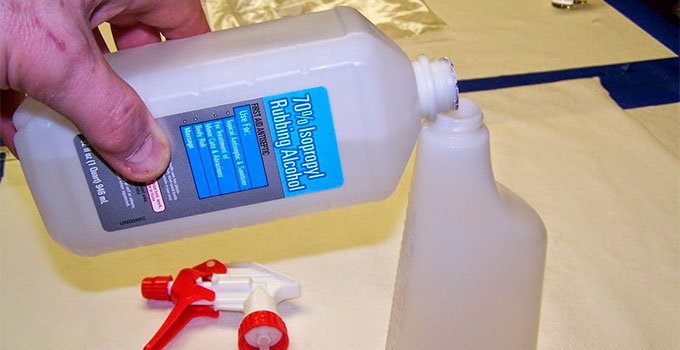
70% Isopropyl Rubbing Alcohol
Budget PickHow Does It Work
How to Use
- Fill a spray bottle with undiluted 70% isopropyl alcohol
- Spray directly on visible bed bugs and suspected hiding spots
- Apply to mattress seams, box springs, and along baseboards
- Can also be applied to skin to deter bites and soothe itching
- Inexpensive and readily available
- Kills on contact with no resistance issues
- Evaporates quickly with minimal residue
- Can be used as both treatment and deterrent
- Limited residual effect
- Not effective against all eggs
- Flammable (keep away from heat sources)
- Requires direct contact to kill bugs
Dealing with Bed Bug Eggs on Clothing
Proper Washing
Wash infested clothing in the hottest water setting safe for the fabric. Hot water helps dislodge and kill eggs attached to clothing fibers.
High Heat Drying
The dryer is your most powerful weapon. Dry clothes at 118°F (medium-high setting) or higher for at least 30 minutes to ensure all eggs are destroyed.
Proper Storage
Store clean clothes in sealed plastic bags or containers to prevent reinfestation during the treatment process.
Bed bug eggs on clothing require special attention, as fabric provides an ideal hiding place. Washing and drying clothes is one of the most effective treatment methods:
- Wash infested clothing in hot water
- Dry on medium-high or higher heat (at least 118°F) for a full cycle
- The dryer heat is more effective at killing eggs than washing alone
- Place clean clothes in sealed plastic bags to prevent reinfestation
Tips for Handling Potentially Infested Clothing
- Transport clothing in sealed plastic bags to prevent spreading eggs
- Don’t place clean clothes on potentially infested surfaces
- Consider dry cleaning for delicate items – inform the cleaner about the infestation
- For items that can’t be washed or dried, consider freezing at 0°F for at least 4 days
Heat Treatment: The Most Effective Solution
Heat is the most reliable method for killing bed bugs at all life stages, including eggs. Professional heat treatments or properly executed DIY methods can effectively eliminate an entire infestation.
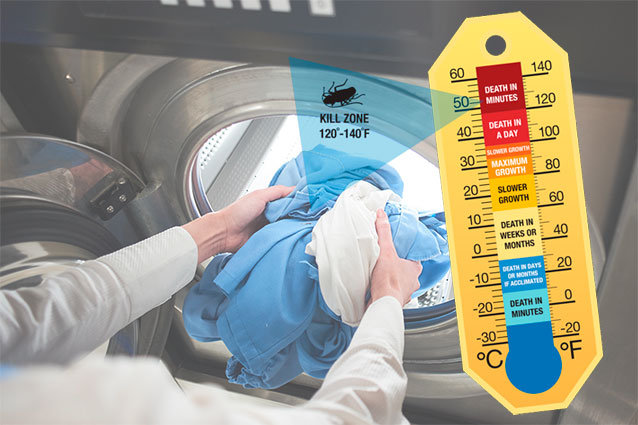
Temperature Requirements:
118°F (48°C) for at least 70 minutes will kill all bed bugs and their eggs. Professional equipment can safely and evenly distribute this heat throughout your home.
Professional Advantage:
Professionals use industrial heaters with temperature monitors to ensure every area of your home reaches the lethal temperature without damaging your belongings.
One-Time Solution:
Unlike chemical treatments that may require multiple applications, a properly executed heat treatment can eliminate an entire infestation in a single session.
Steam Treatment
Steam treatment offers another effective heat-based solution for killing bed bug eggs, especially in fabric and mattress seams.
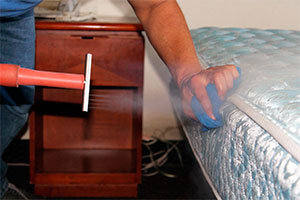
Steam Treatment Tips
- Use a professional-grade steamer that reaches at least 200°F for effective treatment
- Move the steam nozzle slowly (about 1 inch per second) to ensure heat penetrates surfaces
- Focus on seams, tufts, buttons, and edges of mattresses and upholstered furniture
- Allow treated areas to dry completely before use
Professional-grade steamers that reach temperatures above 118°F can penetrate mattress seams, upholstery, and other hiding spots to kill eggs on contact. While this requires special equipment, it’s highly effective for targeted treatments.
| Treatment Method | Effectiveness Against Eggs | Pros | Cons |
|---|---|---|---|
| Heat Treatment | Excellent (kills 100% when proper temperature reached) |
|
|
| Steam Cleaning | Very Good (kills eggs on contact) |
|
|
| Diatomaceous Earth | Good (when in direct contact) |
|
|
| Rubbing Alcohol | Moderate (kills some eggs on contact) |
|
|
Treatment Approach by Infestation Level
The right strategy depends on how severe your bed bug problem is
Light Infestation
- Signs: Few bugs, isolated to one area, recent introduction
- Approach: DIY treatment often sufficient
- Methods: DE, alcohol spray, washing/drying clothes, vacuuming
- Timeline: 2-3 weeks with proper follow-up
Moderate Infestation
- Signs: Multiple bugs in different areas, visible eggs, signs in multiple rooms
- Approach: Combination of DIY and professional methods
- Methods: DE barriers, professional-grade insecticides, steam treatment
- Timeline: 1-2 months with multiple treatments
Severe Infestation
- Signs: Widespread presence, multiple life stages visible, throughout home
- Approach: Professional treatment strongly recommended
- Methods: Whole-home heat treatment, comprehensive professional plan
- Timeline: Immediate relief with heat, follow-up to prevent reinfestation
Conclusion: Breaking the Bed Bug Life Cycle
Killing bed bug eggs is just as crucial as eliminating adult bed bugs. A comprehensive approach that combines multiple treatment methods delivered at appropriate intervals provides the best chance of complete eradication. Remember that what kills adult bed bugs generally also kills nymphs, but eggs require special attention.
The most effective bed bug treatment plans address eggs, nymphs, and adults through a combination of methods.
Schedule a second treatment 10-14 days after the first to eliminate newly hatched nymphs before they can reproduce.
Whether through professional whole-room treatment, clothes dryers, or steam cleaners, heat is the most consistent way to kill bed bug eggs.
Complete eradication requires attention to detail and follow-through. Don’t assume a single treatment will solve the problem.
Diatomaceous earth, rubbing alcohol, heat treatment, and steam cleaning are all valuable tools in your fight against bed bug eggs. While professional extermination services offer the highest success rates, particularly with heat treatments, many homeowners can effectively combat bed bug infestations with proper knowledge and persistence. It’s essential to understand that using a combination of methods often yields the best results. Homeowners should consider integrating bed bug pest control solutions like diatomaceous earth with DIY approaches, ensuring thorough coverage and targeting every stage of the bed bug life cycle. By remaining diligent and proactive, you can significantly reduce the likelihood of a reinfestation and create a healthier living environment.
The key is addressing every stage of the bed bug life cycle, from egg to adult, to break the reproductive cycle permanently. With patience, thoroughness, and the right approach, you can successfully eliminate bed bugs and their eggs from your home.
Frequently Asked Questions
Can bed bug eggs survive washing and drying?
Washing alone may not kill bed bug eggs, as they can be quite resilient to water and detergents. However, the high heat of the dryer is extremely effective at eliminating them. For best results, wash infested items in hot water, then dry them at high heat (at least 118°F/48°C) for a minimum of 30 minutes. This combination of hot washing and high-heat drying will kill bed bug eggs effectively. Items that cannot be washed can often be placed directly in the dryer on high heat to achieve the same result.
How can I tell if I have bed bug eggs in my home?
Bed bug eggs are tiny (about 1mm long), pearly white, and grain-shaped. They’re typically found in clusters in cracks and crevices near where bed bugs hide, including mattress seams, box springs, bed frames, headboards, and furniture joints. Use a flashlight and magnifying glass during inspection, looking for these small white eggs and empty eggshells (which appear translucent). Other signs include small blood spots on bedding, dark fecal spots, shed skins, and of course, the presence of adult bed bugs or nymphs nearby.
How quickly do bed bugs reproduce?
Bed bugs reproduce at an alarming rate when conditions are favorable. A female bed bug can lay 1-5 eggs daily and up to 500 eggs in her lifetime (4-6 months). These eggs hatch in approximately 6-10 days, and the resulting nymphs can reach adulthood in as little as 5 weeks if they have regular access to blood meals. This rapid reproduction cycle explains why small infestations can quickly become major problems—in optimal conditions, a bed bug population can double approximately every 16 days.
Will killing adult bed bugs prevent eggs from hatching?
No, killing only the adult bed bugs will not prevent existing eggs from hatching. Bed bug eggs are independent of the adult bugs once laid and will continue developing and hatching even if all adult bugs are eliminated. This is why effective bed bug treatment requires either: 1) using methods that specifically kill eggs (like heat treatment), or 2) implementing a follow-up treatment about 10-14 days after the initial treatment to kill newly hatched nymphs before they mature and reproduce. A comprehensive approach targeting all life stages is essential for complete eradication.
Can bed bug eggs survive in extreme temperatures?
Bed bug eggs are somewhat resilient but can be killed by extreme temperatures. Heat is particularly effective—exposure to temperatures of 118°F (48°C) for 90 minutes will kill all eggs. On the cold end, bed bug eggs can be killed by freezing, but the process takes longer and requires sustained temperatures below 0°F (-18°C) for at least 4 days. Eggs can survive at cool room temperatures for extended periods, which is why heating methods are generally more practical and effective for treatment than freezing in most household scenarios.

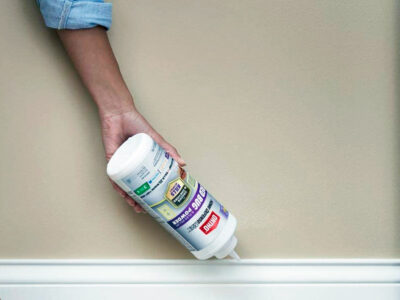
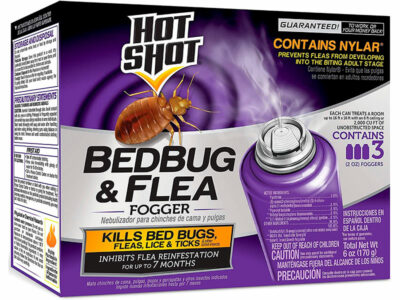

I have the same problem
I was told sabatious earth
Can get it at any hardware store
I am going to get some
Everyone is saying it works I hope so
My husband sleeps in this chair and he has pancreatic cancer with very little time
He will not stay off that chair
I’ve been up all night keeping them bugs off him
Bedbugs have primarily set-up camp in my recliner, and the material is recycled leather with lots of crevices, nooks, and crannies. It’s an expensive electric recliner which I’m still paying for, so if there’s a way to save it, I’d appreciate suggestions. I’ll be using an exterminator to perform a heat treatment, but am unsure if that will kill any bugs/eggs wedged in the chair. Please HELP!
If any of you are interested in the only 100% sure way of getting rid of bed bugs. Research the heat method. It’s the only way to get rid of bed bugs 100%. It is dangerous if you don’t know what your doing. It involves propane heaters.
DE does not deter – it shreds
Bugs can live over a year on 1 feeding
They lay 1 egg per day not 5 / 500 in 365 days
A treatment that kill adults is different from what kills eggs and nymphs
Consider them invisible
Find the Harborage
When the bites stop its not over for 1-4 months treat your space as still effected.
Then you win.
Keep treating every 2 weeks for 4 months then monthly for a year
An investment but worth it
I have washed and dried the clothes on high heat for an hour, and the eggs still will not die. Some things have been done about 6 times, and they are still there. Should I do it over and over? What am I doing wrong?
How are they still alive? Are they moving or hatching?
Not sure what I have if its bed buys are fleas .noticed like pieces of rice at the edges of my carpets.
At night and day I feel like something is bitting me ,my cats at times are scratching notice in one of my ling hair cats that he was bitten by what I do not know .
But I can feel something bitting and crawling on me at night .
I started treating my house with advantage spray for furniture and carpert so far it’s been 4 cans .
Plus have used the Demotion food powder which you need to use a mask for and spread it into my carpets.
Used a treatment on my cats also which was advantage which is 3 treatment but they are still scratching and I am still feeling like something is crawling and bitting me .
Please help I did find something that was white it looked like it was just born it had a head and little legs .
When I broke it with my finger nail it broke easy in half .
Please help me to know what this is fleas are bed bugs .
Bedbugs are usually not interested in pets because the fur makes it impossible to walk around on them and find a capillary to feed from. Think about trying to walk through a thicket in the forest, it’s much easier to walk through an open field. It’s likely to be fleas or some other pest, you would need to capture the pest and show them to someone qualified to identify the pest.
Sorry I should have Proof read before sending
I caught my infestation very early on. I only saw 4 “ Adult“ bugs but the tiny drops of dried blood on my sheets gave them away. I had exterminators in the next day and never saw a adult bedbug again however I build 4 DIY traps and caught and killed 64 newborns over the next 4 weeks. Don’t know how many I would have if I had not killed these baby’s. Be careful with exterminators, they are more interested in controlling the infestation then eliminating the infestation so they can come back multiple times with a new monetary charge each time they visit. If you use a pest control MAKE SURE THEY COME BACK every 2 weeks BEFORE you sign any contract with them. Mine told me they would be back every 6 Months(totally worthless)After there first treatment. If I hadn’t build my own traps and killed the 64 baby’s. I believe my Infestation would be much worse right now If I hadn’t trap the newborns before they had a chance for a blood meal on me. Just go to you-tube and search DIY CO2 traps for bed bugs.(The poor mans advocate) I spent under $20.00 total to build and Replenish my sugar, yeast and 100° water solution every week for four weeks. Don’t put 100% Trust in your pest control company, you also need to take preventative action on your own unless you want to spend thousands of dollars on a company more interest in control then Elimination. I just made new solution two days ago and checked my traps this morning to find two more baby bed bug so I’m not completely out of the woods yet but I have not been bitten in over two weeks. When bed bugs half the first shot on their tiny brain as to find a white male which the CO2 traps will trick them into thinking there’s a blood meal where the CO2 is being emitted. I will keep the traps going until I go the whole week without any baby’s killed. Not time to Relax yet. GOOD LUCK TO ANYONE WHO READS THIS AND GIVES IT A TRY. I just couldn’t sit by and do nothing, I don’t have that ability or patience to sit around and not try something.
I’m interested in knowing more about your traps